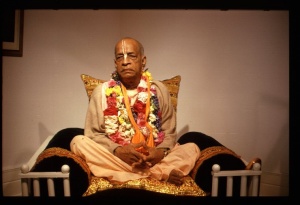CC Madhya 7.113

A.C. Bhaktivedanta Swami Prabhupada
TEXT 113
- ei-mata yāite yāite gelā kūrma-sthāne
- kūrma dekhi’ kaila tāṅre stavana-praṇāme
SYNONYMS
ei-mata — in this way; yāite yāite — while passing; gelā — He went; kūrma-sthāne — to the place of pilgrimage known as Kūrma-kṣetra; kūrma dekhi’ — seeing Lord Kūrma; kaila — offered; tāṅre — unto Him; stavana — prayers; praṇāme — and obeisances.
TRANSLATION
When Lord Śrī Caitanya Mahāprabhu came to the holy place known as Kūrma-kṣetra, He saw the Deity and offered prayers and obeisances.
PURPORT
Kūrma-sthāna is a well-known place of pilgrimage. There is a temple there of Kūrmadeva. In the Prapannāmṛta it is said that Lord Jagannātha took Śrī Rāmānujācārya from Jagannātha Purī and one night threw him to Kūrma-kṣetra. Kūrma-kṣetra is situated on the line of the Southern Railway in India. One has to go to the railway station known as Srikakulam Road. From this station one goes eight miles to the east to reach the holy place known as Kūrmācala. Those who speak the Telugu language consider this holy place very important. This statement is reported in the government gazette known as Gañjāma Manual. There is the Deity of Kūrma there, and, as mentioned above, Śrīla Rāmānujācārya was thrown from Jagannātha Purī to this place. At that time he thought that the Deity of Kūrma was Lord Śiva’s deity; therefore he was fasting there. Later, when he understood that the kūrma-mūrti was another form of Lord Viṣṇu, he instituted very gorgeous worship of Lord Kūrma. This statement is found in the Prapannāmṛta (Chapter Thirty-six). The holy place of Kūrma-kṣetra, or Kūrma-sthāna, was actually reestablished by Śrīpāda Rāmānujācārya under the influence of Lord Jagannātha-deva at Jagannātha Purī. Later the temple came under the jurisdiction of the king of Vijaya-nagara. The Deity was worshiped by the Vaiṣṇavas of the Madhvācārya-sampradāya. In the temple there are some inscriptions said to be written by Śrī Narahari Tīrtha, who was in the disciplic succession of Madhvācārya. Śrīla Bhaktisiddhānta Sarasvatī Ṭhākura explains those inscriptions as follows: (1) Śrī Puruṣottama Yati appeared as the instructor of many learned men. He was a very favorite devotee of Lord Viṣṇu. (2) His preaching was accepted throughout the world with great respect, and by his power he liberated many nondevotees with strong reason and logic. (3) He initiated Ānanda Tīrtha and converted many foolish men to accept sannyāsa and punished them with his rod. (4) All his writings and words are very potent. He gave people devotional service to Lord Viṣṇu so they could be elevated to liberation in the spiritual world. (5) His instructions in devotional service were able to elevate any man to the lotus feet of the Lord. (6) Narahari Tīrtha was also initiated by him and became the ruler of Kaliṅga Province. (7) Narahari Tīrtha fought with the Śabaras, who were caṇḍālas, or hunters, and thus saved the temple of Kūrma. (8) Narahari Tīrtha was a very religious and powerful king. (9) He died in the Śaka Era 1203, in the month of Vaiśākha, in the fortnight of the moon’s waxing period, on the day of Ekādaśī, after the temple was constructed and dedicated to the holy name of Yogānanda Nṛsiṁhadeva. The tablet is dated 1281 A.D., 29 March, Saturday.